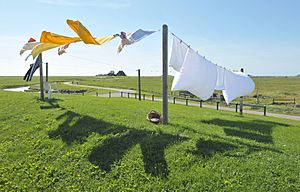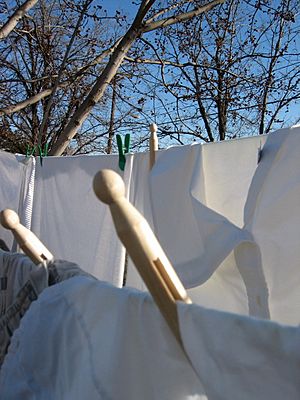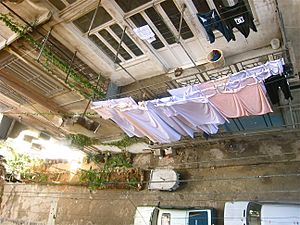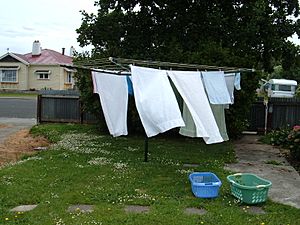Clothesline facts for kids

A clothes line or washing line is a simple way to dry your clothes. It's basically a rope or cord stretched between two points, like two poles or a wall and a pole. People hang their freshly washed clothing on the line to dry in the air and sun. They use small clips called clothespins or pegs to hold the clothes on the line.
You often see clotheslines in back gardens or on balconies. If a clothesline is very long, it might need a stick or prop in the middle to hold it up. This helps because wet clothes can be quite heavy!
Some clotheslines are more modern. They can be round or square, with many lines, and can even fold up when you're not using them. This saves space. In Scotland, some apartment buildings have a shared "drying green." This is a common area where people hang their clothes to dry. They also use it for playing!
Contents
Why Use a Clothesline?

Using a clothesline has many good points. It's a simple and eco-friendly way to dry your laundry.
Benefits of Air Drying Clothes
- Saves Money: You don't need electricity or gas, so it costs nothing to dry your clothes.
- Good for the Planet: Clotheslines don't create pollution, unlike electric dryers.
- Gentle on Clothes: Air drying is softer on your clothes, so they last longer. Hot dryers can make clothes wear out faster.
- No Shrinking: Your clothes won't shrink when air dried, which can happen in a hot dryer.
- Fresh Smell: Clothes dried outside often smell fresh and clean from the air. They also won't have static cling, so they don't stick together.
- Less Wrinkles: If you dry clothes in a breeze, they might come out less wrinkled, meaning less ironing for you!
- Quiet: Clotheslines don't make any noise, unlike noisy dryers.
Challenges of Clotheslines
While clotheslines are great, there are a few things to consider:
- Takes More Time: Hanging clothes one by one can take longer than just tossing them into a dryer.
- Weather Dependent: If it rains, your clothes might get wet, or you'll have to dry them inside.
- Appearance: Some neighbors might not like the look of clothes hanging outside.
- Privacy: Hanging clothes outside can show others what you wear, which some people might not like.
- Risk of Damage: Clothes can get dirty from dust, pollen, or even bird droppings. There's also a small risk of theft.
- Clothespin Marks: The clips can sometimes leave small marks or even rust stains on your clothes.
Drying Clothes Inside
Sometimes, you might need to dry your clothes indoors. This could be for several reasons:
- Bad Weather: If it's raining or too cold outside.
- No Outdoor Space: You might not have a garden or balcony for a clothesline.
- Protecting Clothes: The sun's strong UV rays can sometimes fade or damage fabrics over time.
- Privacy: You might prefer to keep your laundry private.
- Convenience: It might just be easier to dry them inside.
There are special tools for indoor drying. A drying rack or clotheshorse can help save space in an apartment. You can also string clotheslines in a basement. For small items, you can even drape them over furniture or a shower curtain rod. Drying clothes indoors usually takes longer because there's no direct sun or wind to help speed things up.
Images for kids
-
Clotheslines made with polyurethane fiber.















